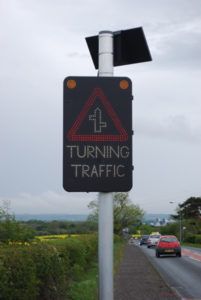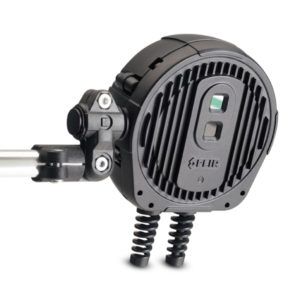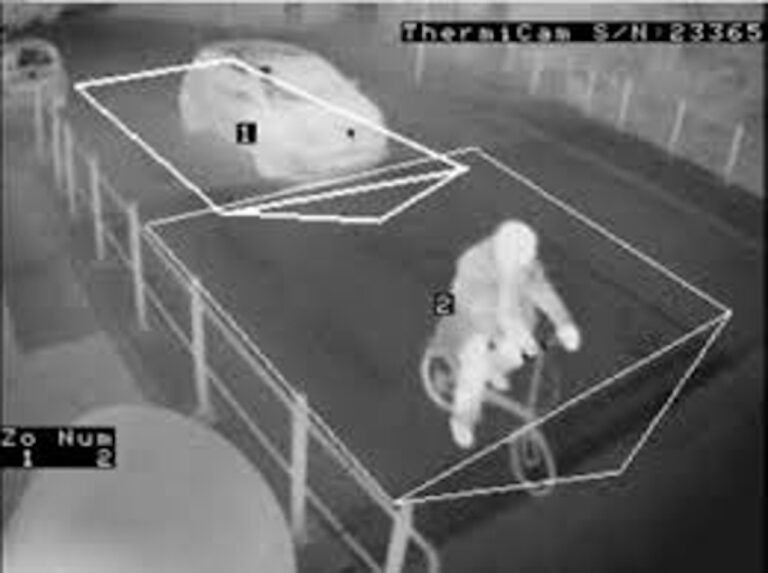UK traffic safety specialist Westcotec teamed up with sensor systems and thermal imaging equipment manufacturer Flir Systems Inc. to build a unique collision avoidance system at an accident blackspot near the city of Durham that has reduced collisions by 100%.
Durham City Council decided to take action to prevent further incidents at a serious accident hotspot at a staggered intersection on the B6532 and contracted Westcotec to provide a reliable safety solution. After initial on-site consultation with the Durham CC’s highways team, Westcotec proposed to build a Collision Avoidance System (CAS) using the latest above-ground thermal detection sensor, coupled with electronic warning signs. The staggered junction now features two vehicle-activated signs (VAS), one in each direction, with warning triangles, corner amber flashers and a message that reads, ‘Turning Traffic’ beneath. The electronic signs warn motorists of the potential hazards at the crossroads, but only when vehicles on the side roads are waiting to cross or want to join the main road.
 Two above-ground thermal detectors from Flir detect vehicles waiting at the stop line on the side roads or vehicles waiting to turn right off the main road. On detection, a signal is sent to the electronic signs, which puts the signalization into action. One thermal camera can cover the entire waiting area at the junction, resulting in only two cameras being required, overall. The system uses two Flir TrafiOne thermal sensors, all-in-one smart city sensors that can detect vehicles 24/7, even in adverse weather or low-light conditions. Unlike inductive loops that can cause traffic disruption during installation and maintenance, thermal cameras do not require the road to be dug up and can be installed on existing infrastructure.
Two above-ground thermal detectors from Flir detect vehicles waiting at the stop line on the side roads or vehicles waiting to turn right off the main road. On detection, a signal is sent to the electronic signs, which puts the signalization into action. One thermal camera can cover the entire waiting area at the junction, resulting in only two cameras being required, overall. The system uses two Flir TrafiOne thermal sensors, all-in-one smart city sensors that can detect vehicles 24/7, even in adverse weather or low-light conditions. Unlike inductive loops that can cause traffic disruption during installation and maintenance, thermal cameras do not require the road to be dug up and can be installed on existing infrastructure.
For the Durham deployment, the connection between the VAS and the thermal sensors is wireless, which, combined with the signs’ solar-power operating system, eliminated the need for a large amount of digging and ducting. The VAS only operate when vehicles approach from the side roads, rather than when traffic is detected on the main road, saving valuable solar energy. The dynamic nature of the installation also increases the visual impact of the warning sign. Since deployment, the system has helped change driver behavior and reduced the number of collisions to zero.
“Efficient signalization can warn motorists of hazards ahead and help them to react safely, but reliable vehicle detection is critical for operation of the system,” said Olly Samways, head of sales and marketing at Westcotec. “We used to work with induction loops, but these systems are not very cost-efficient, unlike thermal cameras, which have become our detection technology of choice. We have been using Flir thermal cameras for bicycle detection and for traffic signal control, but this is the first time in the UK that we have used this technology for a collision avoidance system.”
Sukhdev Bhogal, Flir’s business development director, added, “Warning signs are effective in enhancing driver awareness and that reduce risk of collisions. However, traditional, continuously flashing warning signals have a reduced effect, because motorists do not receive a real stimulus to change driving behavior. This is not the case with detection-based warning signs, which can be activated based on the detected hazardous conditions.”






